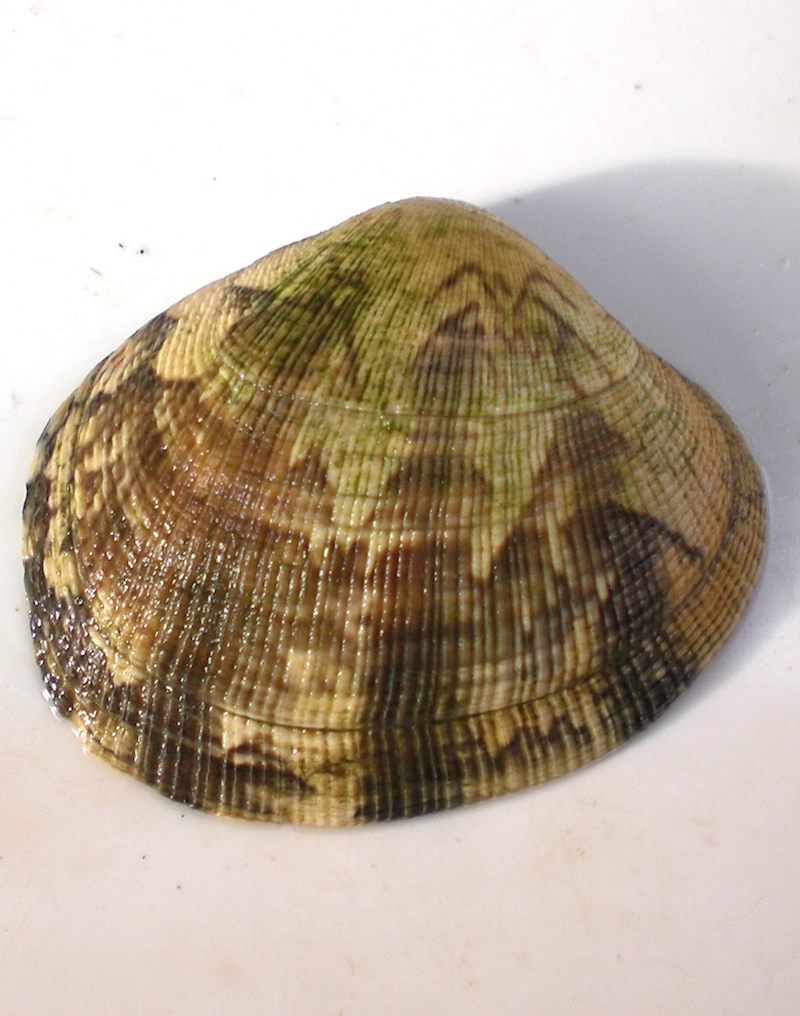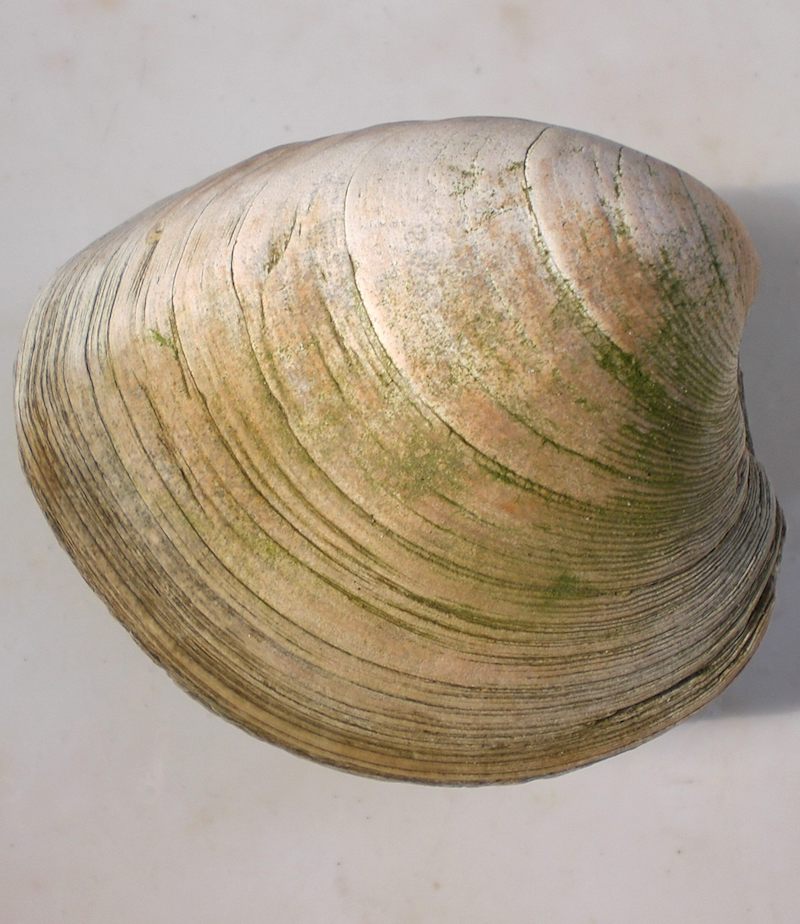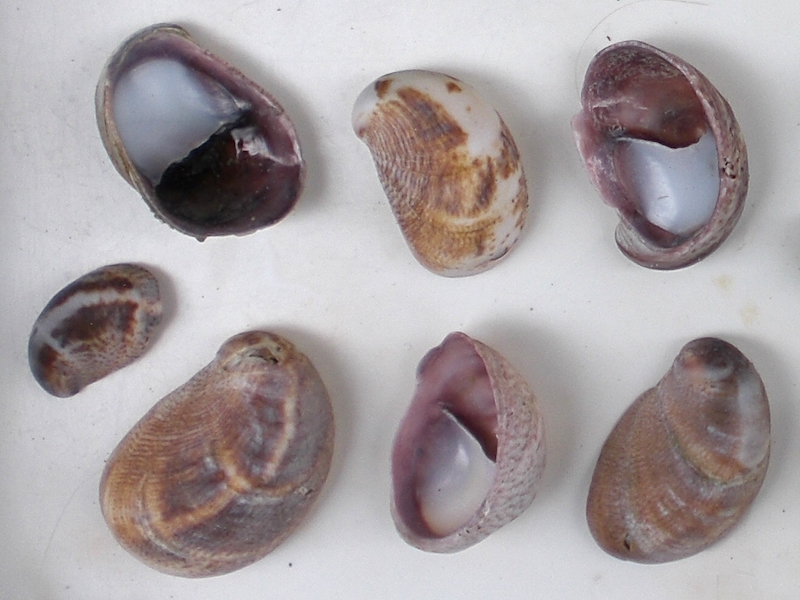|
My apologies for cancelling the field meeting planned for April 2011 due to illness when field work was definitely not on the agenda and no reserve leader could be found. One Hampshire member approached was also out of action with ‘flu and sadly Terry Wimbleton, who knew the Titchfield shore (figure 1) so well, died last year. The special feature of this Solent shore is the living population of Quahogs, Mercenaria mercenaria as well as a general abundance of shells making it a rewarding place for beginners to work. There is also a Visitors’ Centre with facilities and refreshments to escape to if the weather is bad. It is hoped to run the field meeting next year. From the results of previous visits I have been able to compile this article with photographs mostly from a seaweed meeting that I led for Camberley Natural History Society in September 2008. April is usually a good time to go to Titchfield for fresh shells washed up on the shore, including the upper part if it is not possible to wait for the lowest state of the tide. Because of the Isle of Wight just offshore, the Solent experiences curious double tides that are capricious if you are not familiar with them and they involve a longer wait for tides to go out. The Habitats Titchfield is on the south coast between Portsmouth and Southampton. The beach is about two miles south of the village of Titchfield. The River Meon, a chalk stream that powered a corn mill, was once navigable. The church dates back to Saxon times and old maps indicate that Titchfield was a port. A sluice on the shore by the Visitors’ Centre today marks the entry of the river into the harbour, now used for leisure sailing boats instead of the cargo and fishing vessels of earlier times. In the 17th century a canal was made to connect the sea with the village, blocking up the earlier estuary of the River Meon to give a marsh and grazing land. A sea lock, by the narrow road along the canal, was completed by 1610 under the 3rd Earl of Southampton but the canal was redundant a hundred years later and a road bridge was built across the sea lock. Vessels had to wait until high tide to float into the canal. The old canal now provides two miles of freshwater habitat with public footpath access. The first part of the planned field meeting in April was to work the canal for freshwater molluscs whilst waiting for the beach to be exposed. The shore at Titchfield is protected by a sea wall (figure 2), on top of which is car parking and the shore road. The sea wall was, in the 1970s, made of Bembridge Limestone from the Isle of Wight that had plenty of crevices from fossil holes where the cast had dropped out and these used to be colonised by the Dwarf Winkle Melaraphe neritoides. More recently the sea wall has been rebuilt with smooth curved surfaces that offer very little scope for upper shore crevice dwellers as well as being virtually impossible to scale when colonised with slippery green seaweed. It is possible that the Dwarf Winkles might still be on the harbour wall. The top of the shore is steeply shelving flint shingle with muddy sand flats beyond with some bound shingle exposed as the tide goes out. The strand line on the top of the shore is worth examining in April, regardless of the type of tide, as much fresh material is then washed up. Below the sea wall near the harbour are wooden groynes built on the upper shore to control the longshore west–east drift of shingle as waves of the prevailing south–west winds hit the shore at an angle. The groynes are well colonised by seaweeds and are home to upper shore molluscs like Rough and Flat Winkles (Littorina saxatilis agg. and L. littoralis agg.) and some Common Limpets (Patella vulgata) as well as Edible Mussels (Mytilus edulis) anchored by byssus in the crevices. The groynes do not extend far down the shore. The muddy sand exposed at low tide is inhabited by Edible Cockles (Cerastoderma edule) and their paired freshly dead shells are commonly exposed, while live ones can be found at low tide where the wading birds like Oystercatchers will be looking for them. Titchfield is a good place for birds with waders, waterfowl and birds of the reed beds in the Haven. Edible Winkles (Littorina littorea) browse on bottom detritus and seaweed on the mud and bound shingle. Here, although there are no rockpools, tufts of red algae attach to the bound shingle at low shore and it is worth washing this, as well as red weed cast up for small shells and also holdfasts of Oarweeds (Laminaria spp.) that often host Blue–rayed Limpets (Helcion pellucidus). Although there are winkles, Littorina spp.), top–shells (Gibbula umbilicalis and G. cineraria), American Slipper Limpets (Crepidula fornicata), Netted Dog–whelks (Hinnia reticulata), Edible Whelks (Buccinum undatum) and Sting Winkles (Ocenebra erinacea), it is the bivalves that dominate in numbers of shells found on this shore of muddy sand. Carpet Shells Traditionally there were two species commonly found here, the Pullet Carpet Shell (Venerupis senegalensis) and the Cross–cut Carpet Shell (Tapes decussata) distinguished by the prominence of radial ribbing and the form of the pallial sinus and pallial line muscle scars that relates to the length of siphons and depth of burrows. However in recent years there has been a colourful new arrival in the form of the Japanese Carpet Shell (Ruditapes philippinarum) that a few years ago (2008) were especially abundant (figure 3). British seashell books do not cover them. Where had they come from? For some years there has been aquaculture of molluscs on the Isle of Wight, not far offshore, so perhaps that was a source via pelagic larvae. Internet sites on aquaculture refer to its introduction to Poole in Dorset in 1988 where it proceeded to naturalise, so pelagic veliger larvae might have come from there on the south–west prevailing waves. They have a particularly colourful and patterned shell and very strong radial ribbing giving a decussate appearance. Their similarity to Tapes decussata is emphasised by a synonym semidecussata. The Quahog This introduced species from North America is abundant on the Solent shore at Titchfield both as fresh empty shells and living animals at low tide. The Quahog or Hard–shell Clam (Mercenaria mercenaria) is a large thick–shelled bivalve of 5–10 cms belonging to the Venus family or Veneridae.. The outside of the shell is pale brown with the typical heart–shaped mark showing up very well (figure 4), the inside is white but often it is purple at one end, as in the case of Pullet Carpet Shells (figure 5). The Quahog differs from them, not only in the thicker shell and different shape but by having a toothed ventral margin instead of a smooth one. The late David Heppell, a Conchological Society member who once lived in Gosport, found the first live population of Quahogs at Lee–on–Solent, a beach not far to the east of Titchfield harbour and Hillhead. He reported this in the Journal of Conchology (Heppell, 1961) and undertook some literature research into introductions of this bivalve into Britain and France. There were several recorded attempts at deliberate introduction to the Liverpool area from 1869 and the one that succeeded best was in the brackish water of the Dee estuary, but none of these were self–sustaining. The source of supply was a Captain Mortimer from the Atlantic liner America. On the east coast of North America the Hard–shell Clam is very popular seafood being used to make a soup (clam chowder) which I have sampled when in the USA during the 1970s and there are several variations of the recipe according to region. In his literature search David Heppell could find no reference to an intentional introduction of M. mercenaria to the Solent. Whilst liner traffic to America went out of Liverpool in the 19th century, during the 20th century there was much transatlantic liner traffic from Southampton, just west of Titchfield including the Titanic launched from Southampton a century ago. On occasion, when the liners were running in the 1960s, I have seen vast quantities of fresh vegetables washed up on the beach at Hayling Island near Portsmouth. Clam chowder would almost certainly have been on the menu on these American liners, the clams transported live in sacks. A likely source of this population near Southampton Water seem would seem to be from surplus live clams being thrown overboard approaching port. They thrive best in the somewhat brackish waters of estuaries. Investigations also need to be made on their possible culture on the Isle of Wight. In North America the source of clams is from harvesting wild populations. Unlike the very prolific American Slipper Limpet (Crepidula fornicata) (figure 6) accidentally introduced to England with oysters, Mercenaria mercenaria does not appear to do any harm.
Reference HEPPELL, D.,1961. The naturalization in Europe of the Quahog, Mercenaria mercenaria (L.), J. Conch., London: 25 (1), 21–34. |
figure 1: Titchfield beach, looking west. (Photo: June Chatfield)
figure 2: Sea wall, groynes and boulders at Titchfield. (Photo: June Chatfield)
figure 3: Internal and external views of Ruditapes philippinarum. (Photo: June Chatfield)
figure 4: External shell of M. mercenaria, showing the annual growth lines. It is a very long–lived species and this one is probably 20 years old. (Photo: June Chatfield)
figure 5: External shell of M. mercenaria showing the crenulated ventral margin. (Photo: June Chatfield)
figure 6: C. fornicata from Titchfield. (Photo: June Chatfield) |
Titchfield Haven Shore, Hampshire
Issue
27
Page
25







